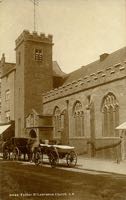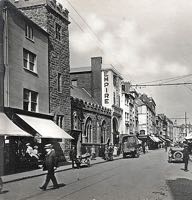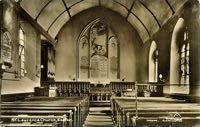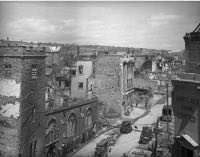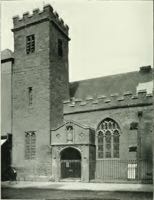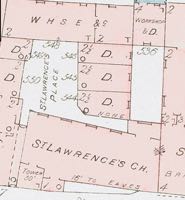
St Lawrence - High Street
Page updated 7th October 2018
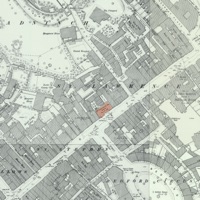 St Lawrence
was one of the churches lost on the 4th May 1942, when the city
suffered its worst bombing raid of
the Second World War. The church was burnt out, but film taken after
the raid indicates the fabric, including the tower, survived.
St Lawrence
was one of the churches lost on the 4th May 1942, when the city
suffered its worst bombing raid of
the Second World War. The church was burnt out, but film taken after
the raid indicates the fabric, including the tower, survived.
Dating from before the thirteenth-century, it was mentioned in a deed of 1202 when it belonged to the abbot and convent of St Mary de Valle in Bayeux, Normandy. In 1275, Henry III gave permission for it to be passed to the Augustinian priory and convent of Merton, Surrey, who in turn gave it to St John's Hospital at the request of Bishop Peter Quivil.
During the Commonwealth, St Lawrence was one of the thirteen parish churches selected for disposal by the Parliamentary Commissioners. It was purchased back by a wealthy parishioner on 21 September 1658, for £100, and returned to the parish, saving it from destruction.
The Church Building
Situated on the northern side of the High Street, the church had an enclosed porch with a Norman arched entrance, constructed in 1674, from the materials of an ornamental water conduit that stood close by, in the middle of the High Street. Over the porch, in a Gothic niche, was a statue of Queen Elizabeth I, which was originally sited on the conduit. The conduit displayed the city coat of arms with the date 1590. In 1804, the statue was the subject of a vandal when on 6 May, the head of Good Queen Bess was removed and placed on a spike in front of the church. Mr John Cooke was commended for offering a reward of five guineas for apprehending the offender.
Although White's directory states it was a neat, plastered building, in 1857 the plaster was hacked off and the stone redressed, while Bath stone battlements were added to the tower and main body of the church. Early photographs of the church indicate a construction of Heavitree sandstone. The church had a tower with a single bell, which replaced two bells which were purchased by the parishioners in 1658 for £100. They were sold in 1780 to raise funds to repair the building. Andrew Brice in the satirical Mobiad relates a humerous story of what was considered to be an odd looking tower.
"A Country Boy, in company with his Mother, happening to pass by this Church, and observing the Tower, mistook it for the Chimney of the adjoining House, and exclaimed to his Parent, "Mother, Mother, what a gurt Chimbley that little House has got,""
Internally there was a chancel, nave, and a north transept. The church was repaired in 1847 when new seating for 350 installed at a cost of £600. In September 1850 the church was again reseated with carved oak pews at a cost of £550. The interior had a handsome carved oak screen and a painted altar-piece by Mr Eastment of Exeter. There were few monuments in the church, perhaps reflecting the lowly position of the worshippers in society. In 1869 a window, made by Frederick Drake, depicting Christ blessing the children, the Good Samaritan and St Peter and St John was installed in memory of Mr Richard Somers Gard MP., by his widow. To the rear of the church was a small churchyard, formerly a garden, which was used to bury the bodies of poor parishioners for free. However, the Devon and Exeter Hospital surgeon Robert Patch was buried in the yard in June 1813. The register dates from 1604.
Get the smelling salts
During the nineteenth-century, the roadway in front of the building was a standing area for flys (horse taxi), which was convenient for patrons of the Three Tuns public house that was directly opposite – there were several prosecutions for bad language and even fighting by the flymen outside St Lawrence, which must have been a trauma for the ladies leaving the church. Flymen were also regularly fined for leaving their horse and fly unattended, probably while they had a swift pint in the pub, rather than a prayer in the church. The building at the east end of the church was from 1910 to 1937 the Empire Electric Cinema which would have proved to be a greater attraction than the old church.
Sources: Whites 1850, Kelly's 1897, The history of the city of Exeter By George Oliver, British Newspaper Archive, Exeter Churches by Edith Cresswell..
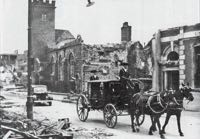
The Sheriff's Coach passes the bombed out wreck of the church, in 1942.
│ Top of Page │
